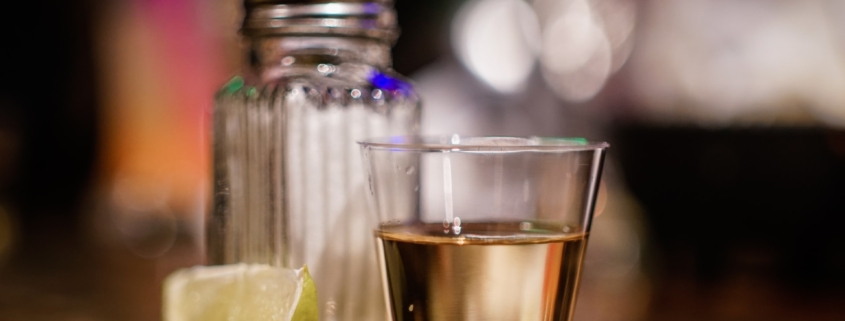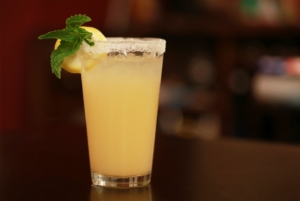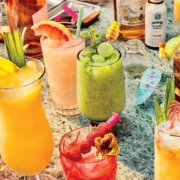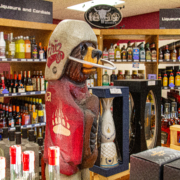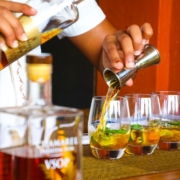Although tequila can hit the spot anytime, summer is one of the best seasons to mix up a drink with this unique spirit. There certainly is something about the flavor of tequila that blends well with citrus and ice on a hot day!
While tequila aficionados will often insist on drinking the liquor straight to discern flavor notes, many of us will choose to mix up a cocktail instead. If you’ve ever wondered how that tequila in your margarita came to be, follow along as we dissect its history, how it’s made, and how to profile this complex Mexican spirit.
What is Tequila?
Tales of tequila’s origin come from many sources, so there isn’t a concrete consensus on its history. We can agree, however, that it is the most recognized spirit produced in Mexico and has been around for thousands of years.
For the spirit to be called ‘tequila’, it has to meet three requirements:
- It must be made in one of five Mexican states: Jalisco, Michoacán, Guanajuato, Nayarit, or Tamaulipas.
- It must be produced from the blue agave plant.
- It has to be approved by Mexico’s Consejo Regulador del Tequila (Tequila Regulatory Council).
The regulatory council is pretty firm for the product on blue agave coming from one of those 5 states. However, the final product can be as little as 51% of actual agave. With other ingredients comprising potentially 49% of the finished product, experienced tasters can pull out those other flavors and nuances. Most tequilas are not 100% blue agave, and the ones that are tend to be quite expensive.
How Tequila is Made
It takes the blue agave plant seven years to reach full maturity and be ready for harvest. Because of the sugars within the plant, even though it takes a long time to mature, it doesn’t really taste like anything until it’s cooked.
There are several ways to cook the agave:
Traditional
One of the earliest methods of cooking agave was to smoke it. A distiller would dig a hole somewhere then fill it with the agave. They’d then lie wood and rocks on top of the pile and set it all on fire. It would create a very smoky flavor in the agave, which is something a few tequila lovers enjoy, but is thought to be ‘dirty’ by others. This method isn’t used by really any of the distillers today.
Horno
This is similar to the first method, except the agave is cooked inside of an oven instead. Horno is still a pretty traditional way of cooking it, but can be a lot more efficient and the process is a lot cleaner than the traditional method.
Autoclave
Now we’re getting into more developed and modern ways of cooking agave. In the autoclave method, the agave is placed inside of a stainless steel oven and cooked for about 9 hours.
Diffusion
This is the most cost efficient method available, but certainly not a popular one for lovers of tequila. A distiller washes the plants, chops them up, then uses a cooking process to extract liquid. Diffusion is regarded as one of the worst ways to make tequila. There are many unsavory parts of the agave that make it into the finished product and change the flavor. So most distilleries will deny having any such device to make their brand of tequila.
How is Tequila’s Flavor Affected?
Depending on the flavor that producers would like to have within their tequila, they need to get their agave from different locations. Flavor is heavily affected by where the blue agave is grown, so the location is very important.
One of the more popular places to grow is Jalisco, which has a volcanic soil. The two places where the agave can be grown in Jalisco are known as the Highlands and the Lowlands. The Highlands sit around 6,000 feet in elevation, whereas the Lowlands are right around 3,800 feet.
The climate and soil profile of the Lowlands produce a more citric, herbal flavor, whereas the conditions in the Highlands will produce a sharp, spicy flavor.
Age is another important factor that affects how a tequila tastes. Unaged tequila will often have more of the citrus flavor, but slightly aged tequila is going to have a spicy profile. The slightly aged varieties may also smell a little like caramel and vanilla. Tequilas that have been aged for a long time are typically going to have sweet and oaky notes.
Age Profiles
Here are some popular tequilas aged for different length of time:
Blanco
Blanco is the unaged tequila that basically goes from the cooking process straight into the bottle. If it spends any longer than two months aging, it’s then considered reposado.
- Espolòn Blanco
- Tapatio Blanco
- Astral
- Casa Noble Crystal
- Siembra Valles Blanco
- Pasote Blanco
- Fortaleza Blanco
- Expresiones Del Corazón Artisanal Edition Blanco
- Roca Patrón Silver
- Casa Dragones Blanco
Reposado
Reposado, meaning “rested”, is aged anywhere between 2 months and 2 years. Examples of reposado tequilas include:
- Siete Leguas Tequila Reposado
- Partida Reposado Tequila
- G4 Tequila Reposado
- Herradura Reposado Tequila
- Clase Azul Reposado Tequila
- Santera Tequila Reposado
- Don Julio Reposado
- ArteNom 1414 Reposado Tequila
- Tequila Ocho Reposado
- Fortaleza Tequila Reposado
- Corralejo Reposado Tequila
- Simebre Valles
Añejo
This is the oldest of the three and includes any tequila over 2 years old.
- Herradura Añejo
- Milagro Añejo
- 1800 Añejo
- Grand Mayan Ultra Aged Añejo
- Patrón Añejo
- Penta Añejo
- 123 Tequila Añejo
- Hornitos Añejo
- Don Julio – 70th Anniversary
- Enemigo 89 Añejo Cristalino
Conclusion
If you’re looking for that perfect liquor to add to a refreshing drink on those scorching end of summer days, tequila just might fit the bill. Whether you’re in the market for a tequila with an earthy flavor or hints of smoke, we have options for every type of sipper at Grizzly Liquor!

